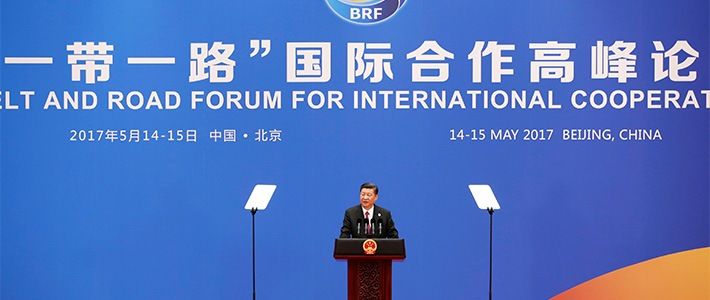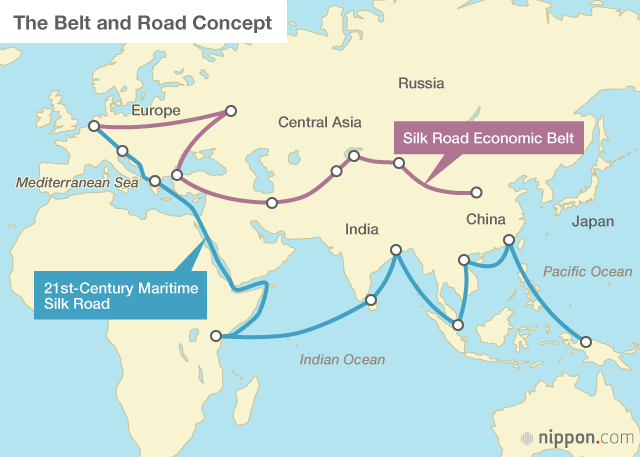
President Xi’s Second Term: Prospects for Japan-China Relations
The Belt and Road Initiative: Responding to Beijing’s Ambitious Endeavor
Politics- English
- 日本語
- 简体字
- 繁體字
- Français
- Español
- العربية
- Русский
An Initiative Serving both International and Domestic Objectives
China’s Belt and Road Initiative is said to have been originally proposed in a speech delivered by President Xi Jinping during a visit to Kazakhstan in 2013. It was based on a number of regional diplomatic undertakings that Beijing had been promoting since the administration of his predecessor, Hu Jintao. These efforts had produced results including the formation of cooperative frameworks with the Association of Southeast Asian Nations, the South Asian Association for Regional Cooperation, and a group of 16 countries in Central and Eastern Europe, along with the establishment of the Shanghai Cooperation Organization. The Belt and Road concept—originally styled “One Belt [and] One Road” in English—represented President Xi’s desire to bring these frameworks together and to present the various infrastructure-building projects being conducted in these regions as part of a single broad endeavor.
The Belt and Road proposal was also motivated by domestic economic considerations. In the wake of the 2008 financial crisis, which set off a global recession, China had overinvested and found itself with excess production capacity. It seems likely that the new initiative was in part aimed at dealing with this excess and giving a boost to the many state-owned enterprises involved in infrastructure construction around the country. They were short of work because of the drying up of demand in this sector following the completion of a round of projects within China; the Belt and Road Initiative offered the prospect of construction work for them in other countries.

Favorable Conditions Bring Progress
The Belt and Road Initiative is not just for show; it has actually made surprisingly good progress, thanks in part to favorable international conditions. The presentation of this proposal coincided with the shrinkage of investment from Japan and the West and an increase in the number of authoritarian regimes, which advanced countries are inclined to shun. These developments made aid and investment from China more attractive. Chinese assistance generally comes in large amounts, the application process is simple and quick, and it is not accompanied by demands relating to democracy or human rights. To be sure, a fair number of the projects undertaken with this assistance have not gone well, but countries in the Belt and Road area and in Africa as a whole have been tending to choose China as their source of support.As the Belt and Road Initiative progresses relatively smoothly, China has also been deliberately getting involved in the provision of international public goods—not just traditional infrastructure like railways, port facilities, and roads, but also advanced, comprehensive systems, such as its satellite navigation system for global positioning, facial recognition technology for public safety, and the Alipay cashless payment platform. This involvement seems to have emerged as a new trend under the Xi Jinping administration. During the previous administration of Hu Jintao, Beijing actively sought to take part in the shaping of global governance, but it fell short in the creation of international public goods.Aside from the provision of international public goods in physical form, a notable feature of the Xi administration has been its drive to offer a model for regional order. This can be seen, for example, in President Xi’s unveiling of his new Asian security concept in May 2014. Back in the early years of this century, it was not common for the Chinese government to make public declarations about Asia, but now Beijing is seeking to become a source of visions for the region.
A Testing Ground for Xi’s “New Type” of International Relations
During 2017, the Belt and Road Forum held in May featured the new initiative as a diplomatic achievement of Xi’s first term as president, and at the National Congress of the Communist Party of China in October, Xi identified this initiative as an element of his proposed “new type” of international relations—a series of partnerships based on economic ties. The Belt and Road Initiative has been positioned as a testing ground for achievement of this type of international relations.The area encompassed by the new initiative includes most of Eurasia, along with East Africa, North Africa, and part of the Pacific, and the idea is to extend China’s partnerships with countries in this area while investing in their infrastructure and strengthening state-to-state and private-sector ties.As China has advanced this initiative, international assessments of it have begun to change. Most of the developing countries in the covered area have come to accept investment from China, even though they are aware of the problems in the Belt and Road concept. And in 2017 Japan started to display a positive view of the initiative, but elsewhere, such as in Western countries and India, which had previously shown favorable attitudes toward strengthening of economic ties with China, critical views of the initiative came to be heard.This contrasting set of changes reflects the difference between Japan and other countries in their prevailing attitudes toward China. In the West and other places, such as India, wariness toward China rose from its previously low level, while in Japan, where the level of wariness was high, it declined. At the June 2017 International Conference on the Future of Asia organized by Nikkei Inc., Prime Minister Abe Shinzō voiced an adjustment of his stance regarding the Belt and Road Initiative, expressing a positive assessment of it—though subject to a number of conditions, such as that it is “critical for infrastructure to be developed through procurement that is transparent and fair” and that it is “essential for projects to be economically viable and to be financed by debt that can be repaid, and not to harm the soundness of the debtor nation’s finances.”(*1) Late in 2017, the Abe administration presented some specific areas in which Japan and China could cooperate, such as distribution and the environment.
(*1) ^ https://japan.kantei.go.jp/97_abe/statement/201706/1222768_11579.html. Accessed June 2, 2018.
Concerns Relating to Systems and Order
Even in Japan, however, and in the countries of the Belt and Road area—as well as in India and the West—quite a few people have been pointing out problems relating to the initiative. Some of these involve the manner in which the Chinese implement projects. There are also problem points concerning the facilities and infrastructure they have built. In addition to such specific issues, there are broader concerns relating to systems and order. Here let me note some examples:
First are the concerns in the economic and political spheres and in the area of military security. Advanced countries have used their economic strength as the basis of their national power and as a diplomatic tool, wielding it, for example, to impose sanctions on countries that disrupt the international order. This pattern can be seen in the way Japan has implemented its program of official development assistance. So it may seem unreasonable to single out the Chinese for using their Belt and Road Initiative as a tool for pursuing their own foreign policy agenda. But China has clearly adopted a two-step process under which the provision of development assistance based on its position as the world’s second-largest economy is followed by the projection of its status as the world’s number-three military power
Also, many of the Chinese companies operating overseas are state-owned enterprises and receive funding from the government-run Export-Import Bank of China. They have much more of a public-sector character than companies from advanced countries. So even what seem to be private-sector activities are often firmly positioned as part of China’s national strategy.
A second concern involves China’s lending. In quite a few cases, the volume of the loans has been in excess of the standards set by the Development Assistance Committee of the Organization for Economic Cooperation and Development, and developing countries have been experiencing fiscal crises—“debt distress”—as they struggle to pay back what they borrowed from China.
When leaders of developing countries are looking for large-scale loans, advanced countries will often decline to provide the volume of funding that they seek, citing the need for soundness in government finances. But if they turn to China, the leaders can get quick, ample funding for use during their own terms of office. In this respect, the Chinese have changed the prevailing order.
The Center for Global Development, a Washington-based think tank, recently published a report titled “Examining the Debt Implications of the Belt and Road Initiative from a Policy Perspective”(*2) in which it identified eight countries at particular risk of debt distress in connection with China’s initiative. In order to pay off their debts, they may offer China port-operation rights or mining rights, or they may provide concessions in the military sphere.
A third concern is the possibility that China may be able to gather personal information about leaders as well as ordinary citizens in countries under authoritarian regimes to which it supplies its satellite navigation and public safety systems. In response to such observations, the Chinese ask why they should be singled out in this way, noting that countries like Britain and the United States have in the past taken advantage of their positions of global leadership to establish fundamental control of communication infrastructure and to draw intelligence from it.
But inasmuch as China lacks democratic systems like information disclosure and protest filing, arrangements for one-way flows of information to the Chinese government and Communist Party may well be seen as changing the prevailing order both within China and internationally.
Creating an Attractive Framework to Maintain the Prevailing Order
How should the international community engage with China?
The first point is to create a multilateral framework for maintenance of the prevailing order and to have many countries commit to it—as seen in the advancement by Japan and other countries of the “free and open Indo-Pacific” concept. This is not a move in opposition to China’s Belt and Road Initiative but one aimed at engagement, with multifaceted significance as a basis for acting in partnership, coexisting competitively, and applying restraint. But unless numerous countries find it attractive, it is liable to look like a self-serving initiative on the part of the countries advancing it, such as the United States, Japan, Australia, and India.
The second point is to encourage China to implement the Belt and Road initiative and the various policies under its “new type” of international relations, of which this initiative is an element, in conformity with the prevailing economic and financial order. To make this happen, it will be necessary to cooperate with the developing countries receiving Chinese assistance and strengthen their ownership of the development process so that they can assert themselves in their dealings with China.
In particular, the international community should engage closely with the governments of developing countries and keep in touch with conditions in local societies instead of taking the approach of cutting off assistance to countries and governments that fail to meet strict conditions relating to democracy and human rights.
The third point is to build an Indo-Pacific framework for checking, sharing information, and confirming views regarding the current status of China’s military moves and intelligence activities. While there are many concerns about China’s growing presence, so far it seems not to have sent warships to call at the port in southern Sri Lanka to which it was recently granted a 99-year lease. It will be important for countries to share information about matters like these, and also to closely consider what sort of results the various initiatives directed toward China have produced and what sort of perceptions the Chinese hold.
(Originally published in Japanese on May 15, 2018. Banner photo: Chinese President Xi Jinping holds a press conference at the conclusion of the Belt and Road Forum held in Beijing, May 14–15, 2017. © Jiji/Aflo.)(*2) ^ https://www.cgdev.org/publication/examining-debt-implications-belt-and-road-initiative-a-policy-perspective. Accessed June 5, 2018.